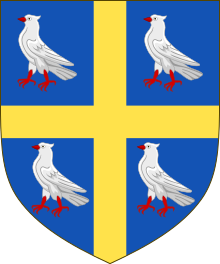Thomas Wriothesley

Sir Thomas Wriothesley (
Personal life
Wriothesley was born at Colatford, Wiltshire. His name at birth was Thomas Writhe, and he was the eldest son and second of four children of John Writhe and his first wife, Barbara, daughter of John Castlecombe.[2] The location of Colatford has not been identified, but it was either near Castle Combe or Cricklade.
Wriothesley's first wife, whom he married before 1500, was Jane, daughter of William Hall of
Heraldic career
In 1489 Wriothesley was made Wallingford Pursuivant in the private service of
As Garter, Wriothesley helped organize and took part in many great domestic ceremonies—the funeral of Henry VII, the coronation of Henry VIII, the
Wriothesley was licensed to carry out
Anthony Wagner has called Wriothesley's Gartership "active, prosperous and in many ways distinguished".[7] Wriothesley's hopes of permanently asserting the primacy of his office over the other kings of arms were dashed in 1530, when Thomas Benolt, Clarenceux King of Arms managed to obtain a commission to carry out visitations without interference by any other herald. After this, Garter King of Arms played no part in the visitation process.
Arms

|
|
See also
- Herald
- King of arms
- The 1511 Westminster Tournament Roll
- The Westminster Challenge
External links
Notes
- ^ Wells, J. C. Longman Pronunciation Dictionary. 3rd edition. Harlow: Pearson Education Limited, 2008.
- ^ Walter H Godfrey and Sir Anthony Wagner, The College of Arms, Queen Victoria Street: being the sixteenth and final monograph of the London Survey Committee. (London, 1963).
- ^ John Anstis. The Register of the Most Noble Order of the Garter. (London, 1724), 2.393.
- ^ a b Noble, Mark (1805). A History of the College of Arms. London: T. Egerton etc. pp. 108–110.
- ISBN 0712345876.
- ^ Wagner, Sir Anthony (1950). A Catalogue of English Mediaeval Rolls of Arms. London: Society of Antiquaries. pp. xi–xii.
- ^ Sir Anthony Wagner. Heralds of England: a History of the Office and College of Arms. (London, 1967), 147.
- ^ Godfrey, Walter H; Wagner, Anthony (1963). "'Garter King of Arms', in Survey of London Monograph 16, College of Arms, Queen Victoria Street (London, 1963), pp. 38–74". british-history.ac.uk. Retrieved 1 November 2018.
